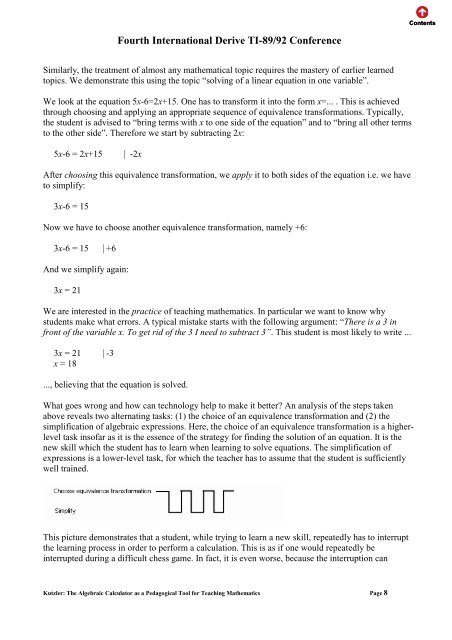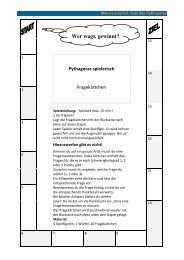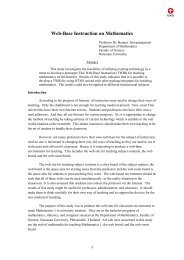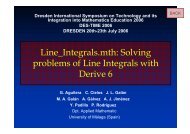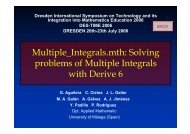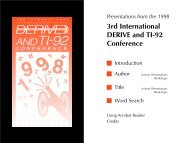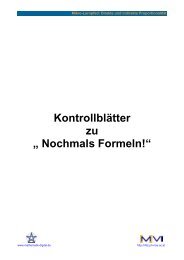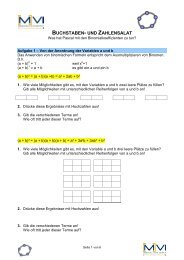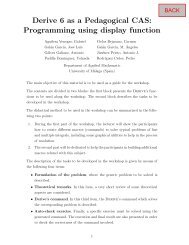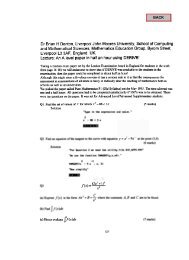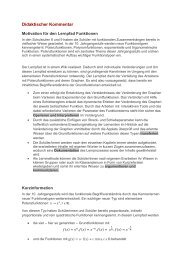The Algebraic Calculator as a Pedagogical Tool for Teaching ...
The Algebraic Calculator as a Pedagogical Tool for Teaching ...
The Algebraic Calculator as a Pedagogical Tool for Teaching ...
You also want an ePaper? Increase the reach of your titles
YUMPU automatically turns print PDFs into web optimized ePapers that Google loves.
Fourth International Derive TI-89/92 Conference<br />
Similarly, the treatment of almost any mathematical topic requires the m<strong>as</strong>tery of earlier learned<br />
topics. We demonstrate this using the topic “solving of a linear equation in one variable”.<br />
We look at the equation 5x-6=2x+15. One h<strong>as</strong> to trans<strong>for</strong>m it into the <strong>for</strong>m x=... . This is achieved<br />
through choosing and applying an appropriate sequence of equivalence trans<strong>for</strong>mations. Typically,<br />
the student is advised to “bring terms with x to one side of the equation” and to “bring all other terms<br />
to the other side”. <strong>The</strong>re<strong>for</strong>e we start by subtracting 2x:<br />
5x-6 = 2x+15 | -2x<br />
After choosing this equivalence trans<strong>for</strong>mation, we apply it to both sides of the equation i.e. we have<br />
to simplify:<br />
3x-6 = 15<br />
Now we have to choose another equivalence trans<strong>for</strong>mation, namely +6:<br />
3x-6 = 15 | +6<br />
And we simplify again:<br />
3x = 21<br />
We are interested in the practice of teaching mathematics. In particular we want to know why<br />
students make what errors. A typical mistake starts with the following argument: “<strong>The</strong>re is a 3 in<br />
front of the variable x. To get rid of the 3 I need to subtract 3”. This student is most likely to write ...<br />
3x = 21 | -3<br />
x = 18<br />
..., believing that the equation is solved.<br />
What goes wrong and how can technology help to make it better? An analysis of the steps taken<br />
above reveals two alternating t<strong>as</strong>ks: (1) the choice of an equivalence trans<strong>for</strong>mation and (2) the<br />
simplification of algebraic expressions. Here, the choice of an equivalence trans<strong>for</strong>mation is a higherlevel<br />
t<strong>as</strong>k insofar <strong>as</strong> it is the essence of the strategy <strong>for</strong> finding the solution of an equation. It is the<br />
new skill which the student h<strong>as</strong> to learn when learning to solve equations. <strong>The</strong> simplification of<br />
expressions is a lower-level t<strong>as</strong>k, <strong>for</strong> which the teacher h<strong>as</strong> to <strong>as</strong>sume that the student is sufficiently<br />
well trained.<br />
This picture demonstrates that a student, while trying to learn a new skill, repeatedly h<strong>as</strong> to interrupt<br />
the learning process in order to per<strong>for</strong>m a calculation. This is <strong>as</strong> if one would repeatedly be<br />
interrupted during a difficult chess game. In fact, it is even worse, because the interruption can<br />
Kutzler: <strong>The</strong> <strong>Algebraic</strong> <strong>Calculator</strong> <strong>as</strong> a <strong>Pedagogical</strong> <strong>Tool</strong> <strong>for</strong> <strong>Teaching</strong> Mathematics Page 8


